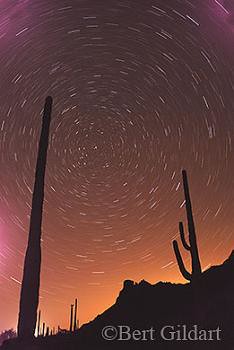Digital Night Photography

Techniques for creating greater arcs
©Bert Gildart: Recently I’ve been sharing photographs with a group of Nikon camera enthusiasts, particularly when I’d like to improve a particular image or know how to do something different.
One such image is attached here (used previously for story about North Star ), and my question was: how can I increase the star trails with digital photography. With the Nikon D200, which I used to make this image, I had set the camera at f 4.8 and placed the shutter on “B,” which holds the camera open until you release the snap on your cable release.
The challenge is to keep the shutter open for hours, rather than for the hour-and-a-half, which seems to be about the limit using Nikon’s EN-EL3e batteries.
Nikon users who have been working with digital images for years seemed to think it was possible, and offered several solutions. One, I could purchase Nikon’s optional MB-D10 battery attachment; or, two, I could purchase one of the Quantum batteries. Both would drastically extend either of my two camera’s abilities to remain open, though the Quantum battery would do it best, keeping the shutter open for the entire evening if I wanted.
The effect of exposures lasting for hours would, of course, be to create star trails that form arcs of about 90 degrees rather than the 12 to 15 degree arcs to which my current setup now limit me, as you can see here.
But extremely long exposures also create another problem, one known as “noise,” or the accumulation of unwanted light spots. High ISO ratings also generate noise, but the D200 and the D300 have a remedy. To eliminate noise, which this image is just on the verge of acquiring, go to Menu>Shooting Menu>Noise and then turn on “Noise Reduction”. According to other digital photographers, that should eliminate the problem. Other camera brands also offer similar remedies.
Of course a person could also revert to film, but for those needing instant results, the problems can apparently be resolved digitally.
Night photography is some of the work I intend to conduct in the Southwest on our upcoming trip, so I was delighted that so many photographers offered their thoughts.


January 12th, 2008 at 5:30 pm
Hello,
I’ve seen this photo on other sites before and think its beautiful. my main question is regarding focus for long exposure night shots such as this. i have been very interested in night photography for some time now and am constantly experimenting but the same problem that keeps cropping up is how to achieve a sharp crisp focus throughout the foreground and background. i have a D200 as well with a nikkor 18-200 lens and the best luck ive had is with really small apertures in the range of f16 and f18, but i see photos like this using a much larger aperture and it baffles me. any insight you may offer would be so very appreciated.
i have a night photography section on my flikr account to explain my problem.
all the best and thank you for your time,
aaron
January 14th, 2008 at 6:00 am
Hi Aaron, You probably saw the photo on the Nikon Forum, but I also used the photo for my Airstream Life magazine story about Organ Pipe. Depth of field is a function not only of f-stops, but also the lens you are using. With wide angle lens, in other words, yours, set at 18mm, you can shoot wide open and be pretty much assured that everything from close up to infinity will be in focus. Not so with a 200mm lens. In my photo above I shot at f5.6, I think, and used a zoom lens but had it set at about 20mm, in other words a wide angle lens. As a result, both foreground and background were in focus.